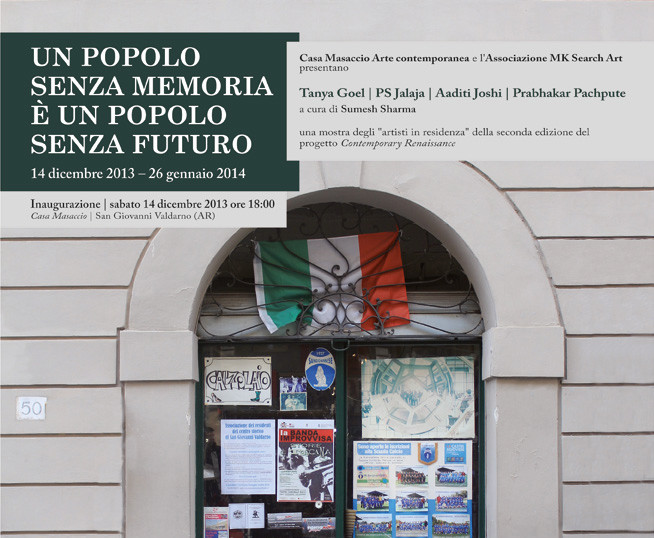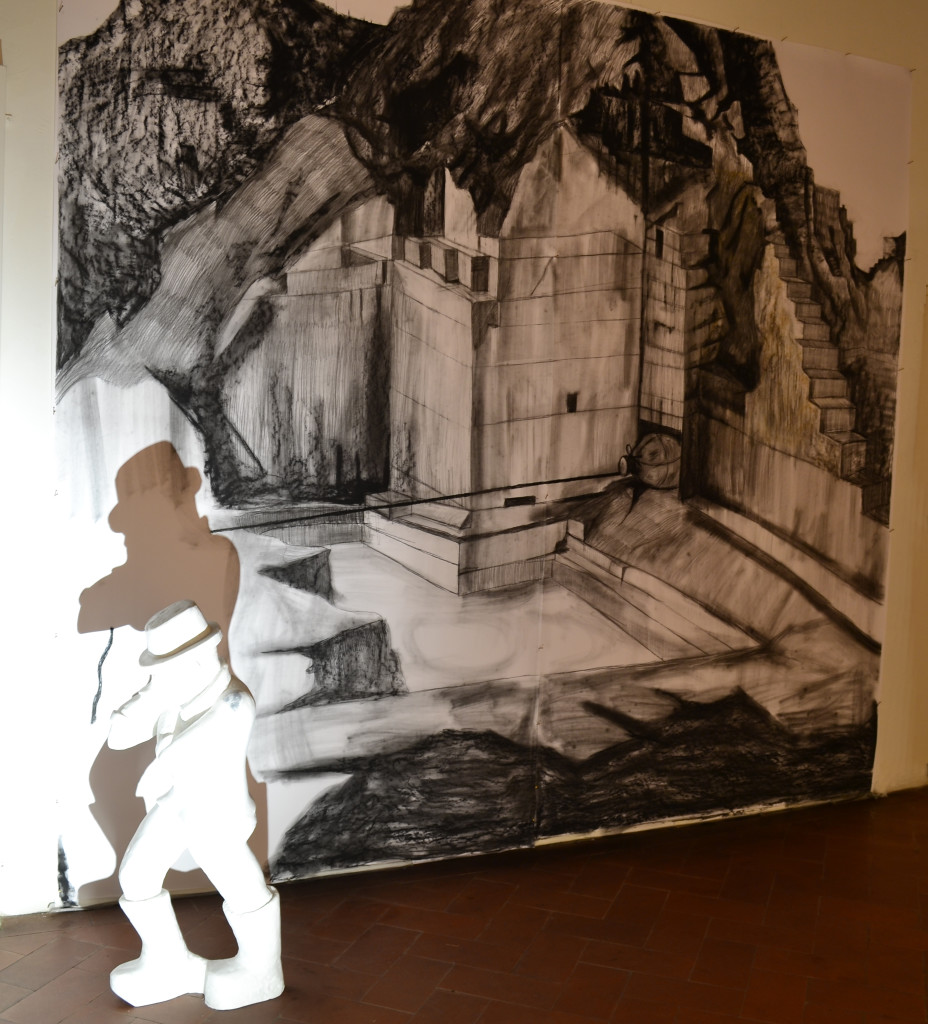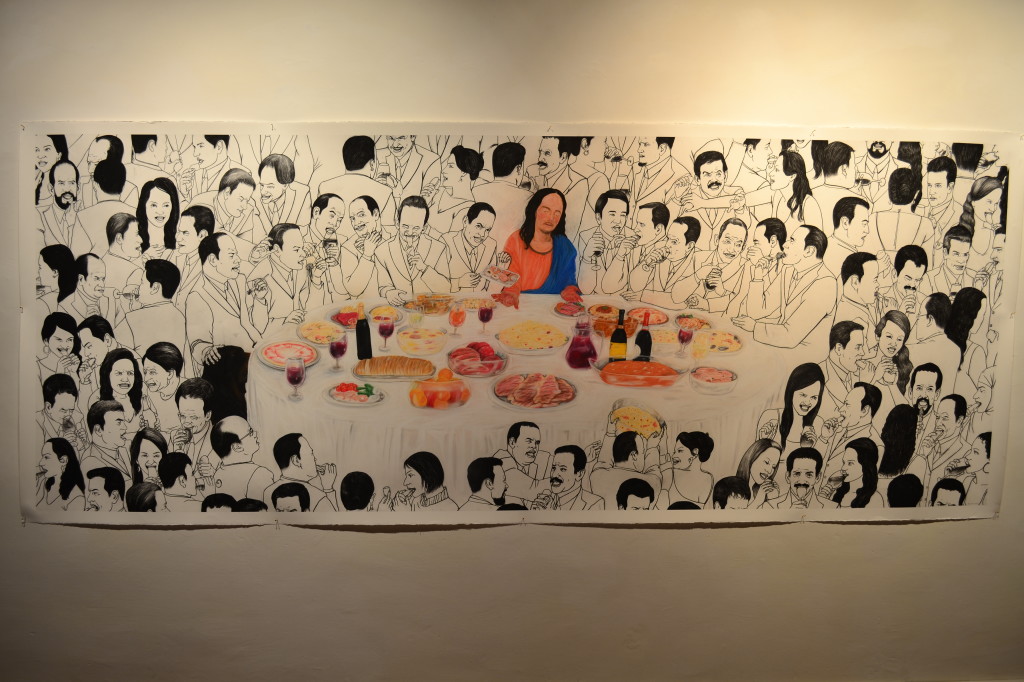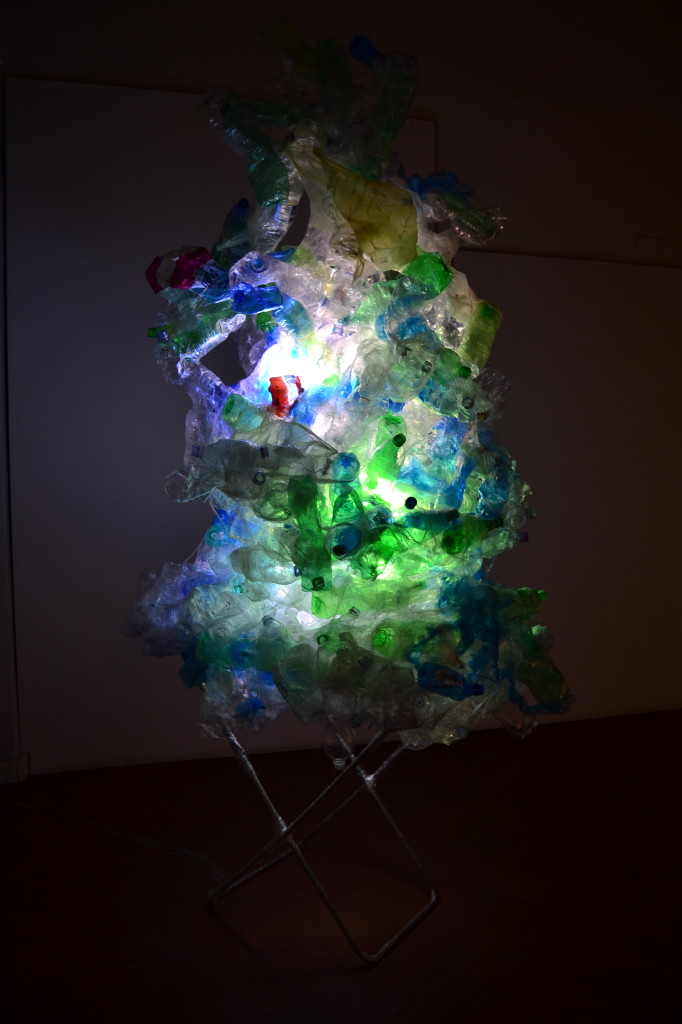UN POPOLO SENZA MEMORIA È UN POPOLO SENZA FUTURO
Tanya Goel – Ps Jalaja – Aaditi Joshi – Prabhakar Pachpute
and a selection from the work of Casa Masaccio collection
Curated by Sumesh Sharma and Serena Trinchero
14th December, 2013 – 26th January, 2014
Casa Masaccio, San Giovanni Valdarno (Arezzo) Italy
Saturday, December 14 Casa Masaccio arte contemporanea and the Italian Cultural Association/MK Search Indian Art (MKSA) present the exhibition UN POPOLO SENZA MEMORIA è UN POPOLO SENZA FUTURO (people without memory is a people without future) curated by Sumesh Sharma and Serena Trinchero. The show, is the final event of the residency project Contemporary Renaissance that this yeat hosted artists Tanya Goel, PS Jalaja, Aaditi Joshi, Prabhakar Pachpute and the curator Sumesh Sharma .
On Saturday, Dec. 14, in occasion of the opening there will be a performance/conversation with Giovanni Pettena and Lapo Binazzi at Bibliocoop, spazio Soci Coop of San Giovanni Valdarno. At 6:00 p.m. is scheduled the opening of the exhibition which will be on display until January 26, 2014.
Casa Masaccio arte contemporanea and the Italian Cultural Association / MK Search Indian Art (MKSA) have promoted for the second consecutive year, the Contemporary Renaissance residence for young Indian artists (under 35) at Casa Masaccio in San Giovanni Valdarno. The project, which has had great reviews in India, is also supported in this second edition to major institutions engaged in promoting cultural exchanges between the two countries, such as Italy-India, the Indo-European Association for fashion and design as well as Embassy of India in Italy and is part of the Regional Initiative Toscanaincontemporanea 2013.
In the house of the great artist, became a space for contemporary creation, the project develops aiming to create a permanent platform for residences of excellence for the mobility of artists, both national and foreign. The invited artists, through their artistic practices and the choice of different media, have been called to question and confront the local community, with art history, economic and social life of the city which over the centuries has experienced various transformations.
The exhibition UN POPOLO SENZA MEMORIA È UN POPOLO SENZA FUTURO presents a reflection that occurs on different tracks with the purpose, not to connect two different cultures, but to propose a new vision for the future through a review of the past. A past not only identified in the glorious and celebrated one of the Renaissance, but also in events closer in time, as the latest edition of Masaccio (1968), which has seen among its protagonists some of the greatest exponents of Arte Povera and which represented a major event for the upgrade to the dictates of contemporary art.
San Giovanni Valdarno is the paradigm of the post-industrial city especially in the eyes of those who come from a strong growth in economy-such as India-which also involves an intensive exploitation of natural resources. With the end of the excavation to search for the lignite and the closure of most of the activities related to it, in an area between San Giovanni Valdarno and Cavriglia, the country seems to suffer a recession exacerbated by the state in which it is currently in the Italian economy. A town stuck in its urban development also physically by enormous factory Italsider, the symbol of a period of industrial prosperity that now seems far away and in time and space. The demand for labor, immigration and emigration are themes that engage and meet with the glorious artistic and cultural history of the place that gave birth to painters such as Masaccio and has been the scene of significant events in the cultural history of the country.
Even the history and role of San Giovanni Valdarno in the context of the contemporary art scene have been deeply investigated: the birth of the collection of Casa Masaccio and challenged last edition of Premio Masaccio in 1968, in fact, an integral part of the final exhibition which will open on December 14th.
Desiring to re-evaluate the past, not limited to the feeling of nostalgia, but on the contrary, aiming to identify clues to address the near future, in the exhibition space, the four Indian artists are in dialogue with masters of the past and some of the exponents of the season in the late Sixties and early Seventies that led Europe in an attempt to effect radical change in vision. Preliminary to this investigation and reflection on the events of 1968 is the performance/conversation, which precedes the opening of the exhibition, with two of its protagonists: Pettena and Lapo Gianni Binazzi; opportunity for discovery and connect with an event of importance national, but somehow forgot .
Tanya Goel, PS Jalaja, Aaditi Joshi, Prabhakar Pachpute share the space with the works of, among others, Giovanni Anselmo, Alighiero Boetti, Renato Guttuso: a dialogue facilitated in many cases by similarities and references in both methodological and conceptual ways. Other works in the collection however, in particular those from the first editions of the Premio Masaccio, established at the end of the Fifties, appearing as evidence of changes in the landscape and the evolution of the city.
Curatorial notes
The door of Aldo Sottani shoe shop stands opposite to Casa Masaccio arte contemporanea, the museum of contemporary art in San Giovanni Valdarno. Information on the various cultural events and news on the local soccer team is often pasted on the glass panes of the door. Behind those doors sits a man who was an apprentice to a shoe-maker since the age of 7. At 83 he repairs shoes so that he can enact the role of the town’s memory, his repair shop a more accurate centre of contemporary culture as it sits not far from the crossroads of the town designed by the Florentine architect Arnolfo di Cambio. The ‘ Calzolaio’ or the shoe shop holds an important image archive. Sottani became a photographer in his early 20s, but he collected images of the town from its past, collecting a large archive that often serves as a source for images during important publications, exhibitions. One such image records Gianni Pettena’s ‘Dialogo Pettena Arnolfo‘ where he boarded up in black and silver the Palazzo d’Arnolfo for the Premio Masaccio, prize organised the city’s council in 1968.
The jury composed by Giovanni Accame, Alberto Boatto, Gillo Dorfles, Corrado Maltese, Guido Montana, Claudio Popovic and Lea Vergine, was invited by the cinema critic Marco Melani, selected 37 emergent italian artists, among them: Carlo Alfano, Giovanni Anselmo, Carlo Cioni, Ugo Nespolo, Alighiero Boetti, Giulio Paolini, Gilberto Zorio, Mario Nigro, Paolo Scheggi that brought about a radical understanding of art practice within Italy. Pettena established himself as an anarchitect.
Four artists from India in residency at the Casa Masaccio began a dialogue with their practice in the post-industrial setting of San Giovanni Valdarno, works that result from this experiment deal with the industrial remnants of production and materials that remain in the city. The title of the exhibition is quotation from a vinyl board outside the abandoned and destroyed coal mining town of Castelnuovo dei Sabbioni just outisde San Giovanni di Valdarno by the Chilean writer and political activist Luis Sepulveda. More than just a warning an attitude, a willingness to reactivation and set in motion that involves the memory of the past as the present and the future.
Artist brief description
Tanya Goel
The artistic work of Tanya Goel is based on the representation of light in art and architecture, due to the use of painting and video. Her interest in colour and pigment is a direct corollary and the result of her preoccupation with surfaces we constantly encounter in everyday life such as electronic signboards, shadows and reflections, moving images and television sets. Within this reflection an important moment will be the perception to the disjunction between colour as light/sight and the material pigments/technologies that embody colour. Those different moment indeed constitute a sort of global language of cities, reflecting a sense of ambiguity, dis-identification and homelessness that now characterize the urban landscape, despite illusory familiarity.
During the period of residency Tanya Goel has pursued her research focusing on the use of a trans-national industrial material, such as cement, studying its reactions with the color and linking its reflection on the reproducibility of the color of the blade Annunciation by Fra’ Angelico, which is in the Museum of the Basilica of Santa Maria delle Grazie in San Giovanni Valdarno.
Inside of the exhibition of her works also will be called upon to engage in dialogue with the work of Giovanni Anselmo, Il panorama intorno fin verso oltremare,1996-1999, and with the works of other artists present inside the collection of Casa Masaccio. In fact, Goel shares with these artists a common methodology in working and surveying, going through a construction of the image or creating a video installation that draws its roots from the reality that surrounds us and the techniques of industrial production, touching elements that involve our existence.
Tanya Goel (1985) lives and work in New Delhi, India. She received her M.F.A in Painting and Printmaking from the Yale School of Art, a post baccalaureate in Painting from the School of the Art Institute of Chicago. She completed her B.F.A from the M.S University, Baroda. She has exhibited her works internationally in several group exhibitions, among them we remember the collective of the Sarai Reader 2013 - Exhibition 09, Devi Art Foundation, New Delhi and the solo show 2 “left from here, Galerie Mirchandani + Steinruecke, New Delhi, 2011.
PS Jalaja
The focus of the work of Ps Jalaja is the man and its relation with time and space. In the eyes of the artist what makes man interesting is the essence of the individual and the loss of its characteristics once it is placed in a wider context, involving more people, and therefore the creation of human history. It’s just the multifaceted landscape of contemporary societies to create the multi-faceted world of paintings and drawings by the artist who seems to want to give voice to all, focusing on the stories of the men within humanity. Every element of her work is the tension with the space, in a tight battle to conquer a way to emerge.
Other constitutive element of the practice of PS Jalaja was the study of the history of the continuous flow of events, fights and lives, as it is today thanks to the thousand images produced by the media that at her eyes appear as events from the great visual strength.
During her stay in San Giovanni Valdarno PS Jalaja has continued her research on man/mankind trying to bring together the reality of Kerala, the region from which she comes, and characterized by a strong artistic culture, especially in the context of the murals with the stimuli found in Italy, thanks to the encounter with the masters of the past, as Leonardo da Vinci. In the exhibition A people without memory is a people without a future her work will engage a dialogue with the painting Still Life by Renato Guttuso .
PS Jalaja (1983) lives and works in Kochi.
He completed her studies at RLV College, Thripunithura in Kochi where she majored in painting and has exhibited his work internationally in group exhibitions. Among her most important exhibitions, the participation at Kochi-Muziris Biennale 2012 and at the Indian Pavilion, Prague Biennale, 2011.
Aaditi Joshi
Aaditi Joshi began to use plastic as a material to develop her artistic practice since April 2005. After the tragic event of the flood in 2006 that caused destruction in his hometown, Bombay, her interest in the material took shape proactively, especially thanks to the discovery of his qualities of strength and durability as opposed to its transparency. The plastic in her vision is not only a way to investigate the consumer society, but also to address issues related to it such as pollution and environmental situation. Through her series of works in plastic the intention is to try to destroy the distinction between form and content thanks to the changing forms that this material is able to take.
During the period of residence at San Giovanni Valdarno, the artist continued her experiments on the use of plastic, requiring the participation of citizens of the Tuscan town for the construction of her work. A real research that can be seen even from the logbook that will be exhibited in Casa Masaccio and that draws the attention of all on a global issue. The works of Aaditi Joshi will be placed in dialogue with the two works by Alighiero Boetti, Zig Zag (1967) and Columns (1968), works participating at Premio Masaccio 1968 and that, in particular Columns, refer to the idea of building a structure heavy and iconic (a column) through the use of a lightweight material and perishable as paper.
Aaditi Joshi (1980) lives and works in Bombay.
She graduated in drawing and painting at the LS Raheja School of Art in Mumbai. It was selected among the 20 finalists of the Skoda Prize 2012 and was awarded a scholarship to the Lucas Artists Residency Program 2012-2014 at the Montalvo Art Center, California. Her work has been exhibited in international exhibitions among which we remind a solo show in 2011, New Works at Gallery Maskara, Bombay and participation at India Focused presented by Creative India Foundation to SH Contemporary Art Fair, Shanghai, China.
Prabhakar Pachpute
From 2010, the subject of the art of Prabhakar Pachpute is the life of the miners and the problems related to the strong exploitation of natural resources in India. A social and human condition that the artist knows well since the city his hometown, Chandrapur is known as the “city of black gold ” and the members of his family for three generations have worked in one of the oldest mines in the country. Because of the affinity between the industrial past of the Arno Valley and the current situation in India, during the period of residency, Prabhakar Pachpute research has focused on the mining history of Castelnuovo dei Sabbioni, the consequences brought about by the end of lignite mining and the advent of post- industrialization. Reflections on the condition of migrants, working conditions in the mines of India as the study of the situation of Carrara and its anarchist roots are able to live thanks to its unique artistic practice based on the drawing. In his works, drawing is frequently associated with the use of shadows create by three-dimensional objects/sculptures, managing to create a special overlay formal languages and different contents.
Prabhakar Pachpute (1986) lives and works in Bombay .
He graduated in Fine Arts at the University Khairagarh, Chhattisgarh and continued his studies at the MS University of Baroda . His first solo show was in 2012, Canary in a Coalmine, Clark Huse Initiative, Bombay. In 2013 he exhibited in group shows such as The Exigence de Saudade, curated by Clark House at Kadist Art Foundation, Paris and Black OR White, curated by Galit Eilat at the Van Abbemuseum, Eindhoven.
Curators’s brief information:
Sumesh Sharma (1980) is a young Indian curator founder with Zasha Colah of Clark House Initiative (Bombay). Clark House Initiative, was established as a curatorial collaborative concerned with ideas of freedom. They curated ‘I C U JEST’, a collateral event of the first Kochi-Muziris Biennale 2012 and more recently, were in residence at the Kadist Art Foundation in Paris.
Serena Trinchero (1985) is an art historian and curator. She is master graduated at Università di Firenze, focusing her researches on relation between America and Europe in Twenties, reading this connection through out the study of little magazine published by Americans in Europe. She cooperated for a didactic program OpenStudios02 with Centro di Cultura Contemporanea Strozzina, Florence and she had curated several contemporary exhibitions involving young artists.
Museo Casa Masaccio
Museo Casa Masaccio is a public space for contemporary art, whose aim is to primarily present the best of Italian and international art. Their activities have created an important dialogue for Casa Masaccio with some of the most prestigious cultural institutions in Europe and internationally such as Maryland Institute College of Art in Baltimore, Association Française d’Action Artistique (AFAA), British Council, Berlinische Galleries, and Museum Boijmans, Rotterdam amongst others. Some of the artists with who Museo Casa Masaccio has collaborated are Bruce Nauman, Franz West, Cornelia Parker, Massimo Bartolini, Alberto Garutti, Mario Airò. Casa Masaccio collaborates with Italian and international emerging and established artists and curators to explore new paths of research. It also promotes opportunities for discussion and development with the young artists of the area, through the creation of laboratories, workshops and exhibitions. Since a few years now, Museo Casa Masaccio has become a permanent platform of residences for the mobility of national and international artists and curators. As the headquarters of the Municipal Collection of Contemporary Art, it preserves works by Alighiero Boetti, Giovanni Anselmo and other important artists, acquired or donated during the Premio Masaccio (1958-1968) and also from exhibitions which have taken place from 1980 onwards, until today.
Mk Search Art
MK Search Art (MKSA) was initiated in 2010 with the production of Crossroads: India Escalate, the Indian section at the fifth edition of the Prague Biennale (2011). The exhibition included 23 artists, and stands as amongst the most incisive representations of the contemporary scene in India within the context of an art biennial. MKSA’s project in Prague was entirely includes conferences and dialogues, which aimed to promote debates and a deeper understanding of contemporary Indian art. Through this project, the Prague Biennale represents the first example of a series of encounters that MKSA proposes at an institutional level in India and Italy, as an attempt to stimulate, through rediscovery, a cultural debate between Europe and India with the idea of extending it to emerging realities.
In 2011 MKSA organized Golden Quadrilateral, a performance by the Indian artist Monali Meher during the traveling exhibition Indian Highway at MAXXI in Rome and within India Day; a day of meetings with international guests dedicated to the cultural relationship between Europe and India and its different disciplines—art, cinema, poetry, literature and philosophy. In 2012 MKSA structured its activity in two main directions. The first, MKSA Association is in continuation with the series of cultural non-for-profit projects, such as the artists’ residency program in collaboration with Casa Masaccio Arte Contemporanea. The second is the foundation of the MKSA Gallery promoting emerging artists within the international context. In this context, and within this philosophy in these 12 months were realized a double personal exhibition by Monali Meher and Remen Chopra (Il Siero della Verità), a show by Alice Tomaselli (il dilemma dell’avanzo) and an exhibition by Lucie Fontaine (Focaccia + Panino + Pizza + Tarallo). In 2013 MKSA, that now has an exhibition venue in San Giovanni Valdarno and one in progress in New Delhi, has been selected to participate at India Art Fair (IAF) where it presented a multicultural project featuring artists from India Indonesia, UK, US and Italy. In 2014 MKSA will be again at IAF, that represent the first fair in the Indian context.
Casa Masaccio Centro per l’Arte Contemporanea
Corso Italia 83, 52027 San Giovanni Valdarno
Ph. 055 91.26.283 HYPERLINK “http://www.casamasaccio.it/”www.casamasaccio.it
e.mail: casamasaccio@comunesgv.it
free entrance
Mon-Sat 15.00 – 19.00 \ Sun 10.00 – 12.00 | 15.00 – 19.00
MK Search Art Association
Corso Italia 14, 52027 San Giovanni Valdarno
www.mksearchart.com
e-mail: info@mksearchart.com
Press Office : Ambra Nepi Comunicazione
Ph. 348-6543173
e.mail: HYPERLINK “mailto:info@ambranepicomunicazione.it”info@ambranepicomunicazione.it
HYPERLINK “http://www.ambranepicomunicazione.it/”www.ambranepicomunicazione.it


Prabhakar Pachpute, Followers of Marzocco, 2013, installation, variable dimensions

Tanya Goel, RGB (screen pattern 1), 2013, oil on canvas

Tanya Goel, Dettaglio (Beato Angelico), 2013, print on cement, 50x50 cms

Prabhakar Pachpute, It was never mine, but now it is a mine, 2013, installation, variable dimensions

Prabhakar Pachpute, 2013, installation, variable dimensions

Ps Jalaja, The anger for decipe, 2013, watercolor on paper

Ps Jalaja, Deep dose of melanin, 2013, watercolor on paper

Aaditi Joshi, Untitled, 2013, plastic sculpture